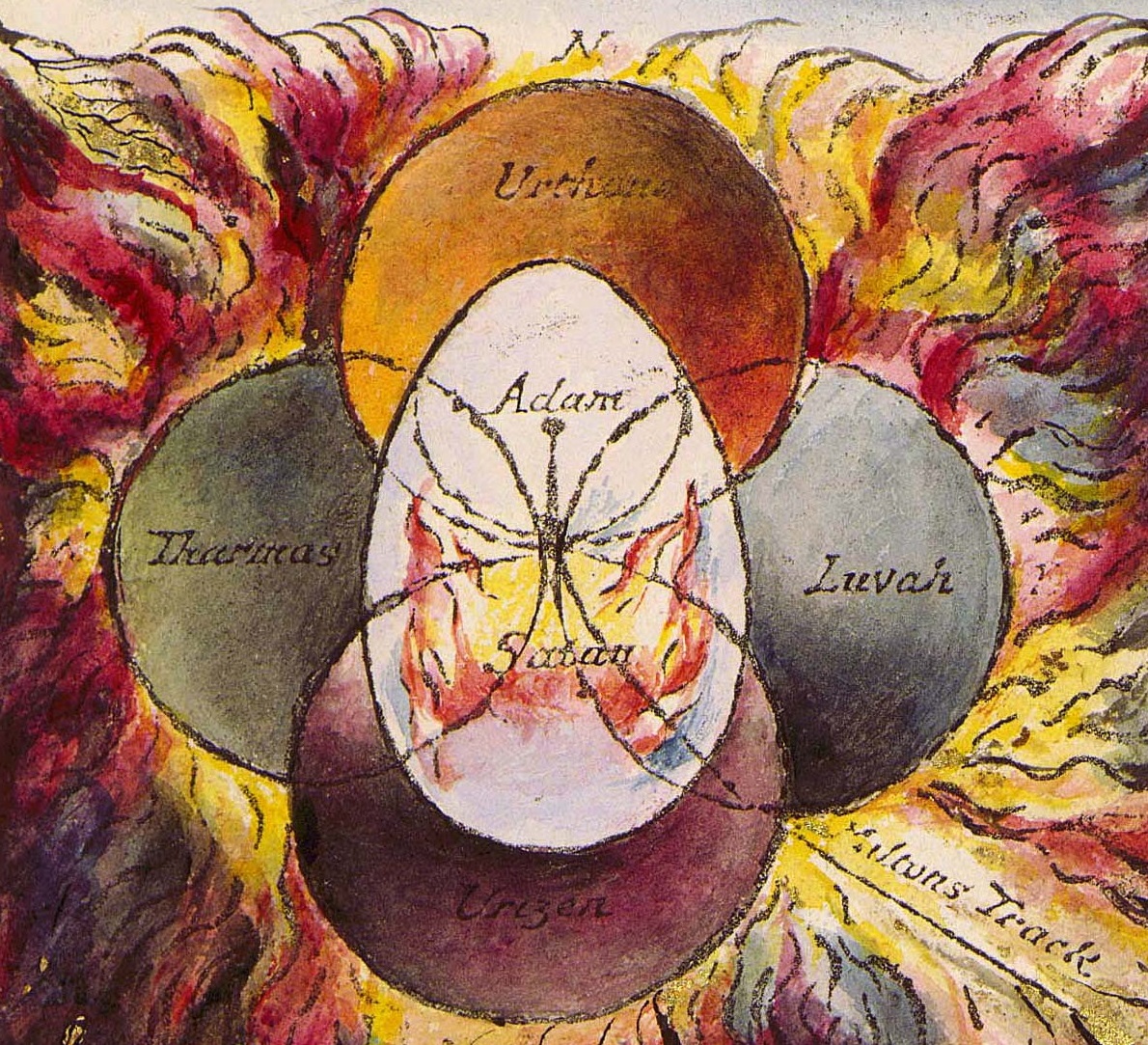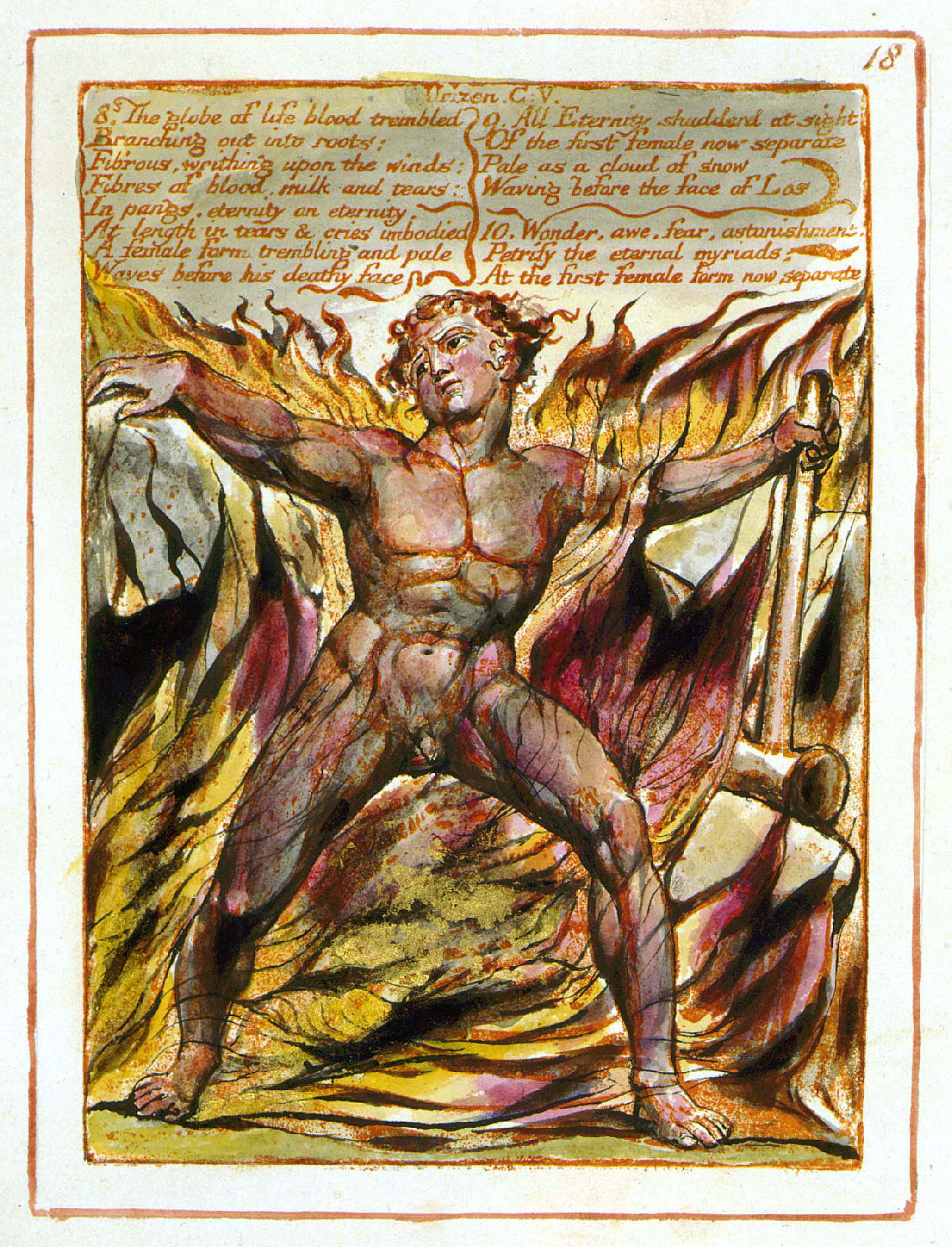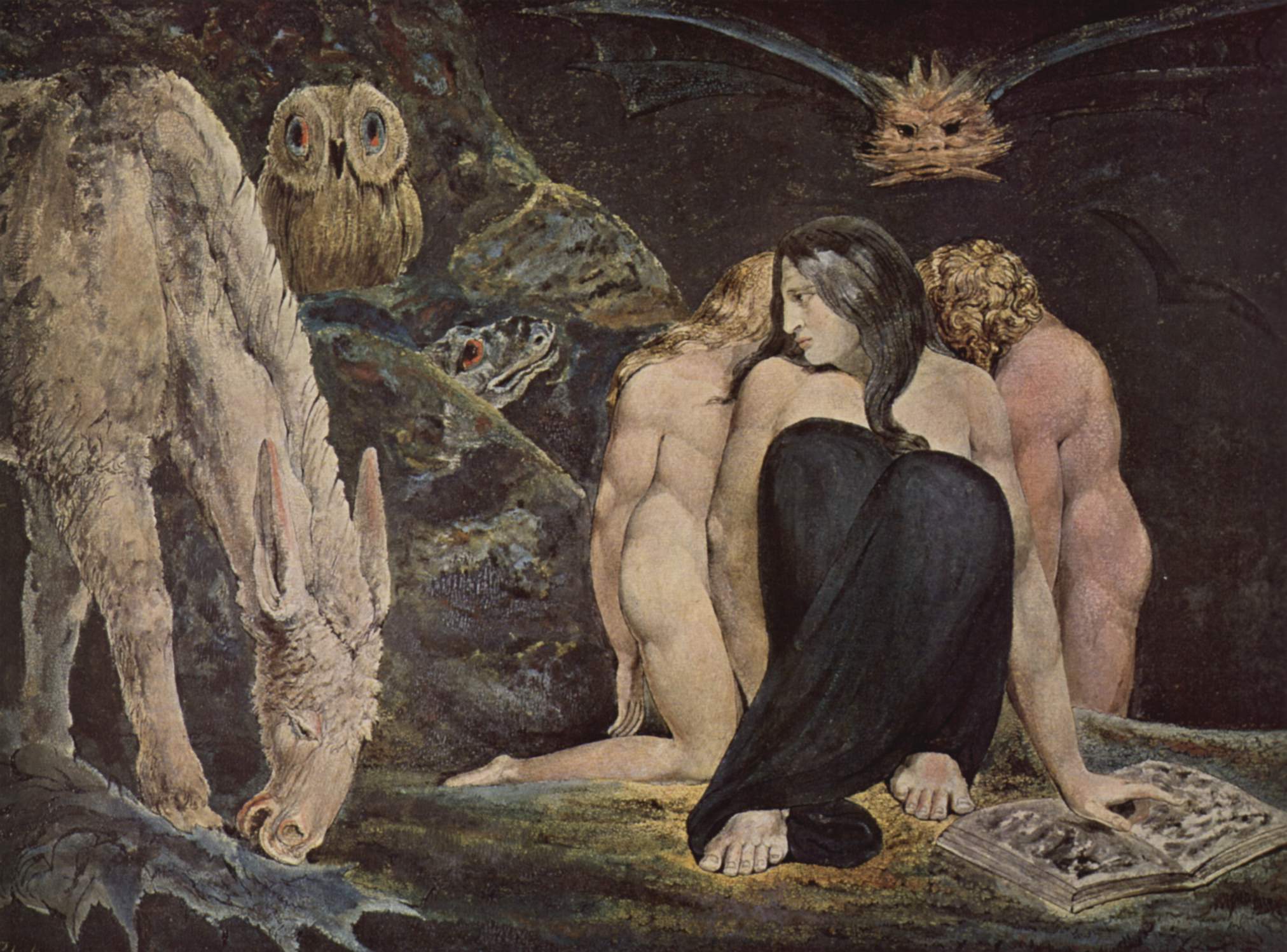|
Luvah
In the mythological writings of William Blake, Luvah is one of the four Zoas, who were created when Albion, the primordial man, was divided fourfold. He represents love, passion, and rebellious energy. His Emanation (female counterpart) is Vala; his fallen form is Orc. Throughout Blake's mythological system, he is opposed to Urizen, the representation of reason. He is also connected to Jesus, who takes upon his form as the being of love after Luvah falls and turns to a being of hate. Character Luvah represents a generative aspect that is connected to experience. In Blake's system, Luvah, the third Zoa, represents emotion as the Prince of Love, and his name may be connected to the word "lover". Love is the supreme emotion, and it is connected to all others, including hate. Luvah is connected to the heart. He is connected to Jesus, and the Incarnation is the result of Luvah transforming into hate; Jesus replaced Luvah's physical form after Luvah descended from his position. As such ... [...More Info...] [...Related Items...] OR: [Wikipedia] [Google] [Baidu] |
William Blake's Mythology
The prophetic books of the English poet and artist William Blake contain an invented mythology, in which Blake worked to encode his spiritual and political ideas into a prophecy for a new age. This desire to recreate the cosmos is the heart of his work and his psychology. His myths often described the struggle between enlightenment and free love on the one hand, and restrictive education and morals on the other. Sources Among Blake's inspirations were John Milton's ''Paradise Lost'' and ''Paradise Regained'', the visions of Emanuel Swedenborg and the near- cabalistic writings of Jakob Böhme. Blake also included his own interpretations of druidism and paganism. The Fall of Albion The longest elaboration of this private myth-cycle was also his longest poem, '' The Four Zoas: The Death and Judgment of Albion The Ancient Man'', written in the late 1790s but left in manuscript form at the time of his death. In this work, Blake traces the fall of Albion, who was "originally fourfol ... [...More Info...] [...Related Items...] OR: [Wikipedia] [Google] [Baidu] |
Enitharmon
Enitharmon is a major female character in William Blake's mythology, playing a main part in some of his prophetic books. She is, but not directly, an aspect of the male Urthona, one of the Four Zoas. She is in fact the Emanation of Los, also male. There is a complex verbal nexus attached. The Zoa Tharmas has emanation Enion, and Eni-tharm(as)-on is one derivation of her name. That should perhaps be read in the inverse direction though, as a construction of the Tharmas/Enion pair's names. Within Blake's myth, she represents female domination and sexual restraints that limit the artistic imagination. She, with Los, gives birth to various children, including Orc. Background It is possible that the character Enitharmon was based on Blake's wife, Catherine Blake. In a letter from Blake to his friend Thomas Butts, Jr. on 22 November 1802, he claimed that his place at Surrey had "Enitharmon's bower". S. Foster Damon explained the name Enitharmon as a derivation or an elision of ... [...More Info...] [...Related Items...] OR: [Wikipedia] [Google] [Baidu] |
Jerusalem The Emanation Of The Giant Albion
''Jerusalem: The Emanation of the Giant Albion'' (1804–1820, with additions made even later) is a prophetic book by English poet William Blake. ''Jerusalem'' is the last, longest and greatest in scope of Blake's works. Etched in handwriting, accompanied by small sketches, marginal figures and huge full-plate illustrations, it has been described as "visionary theatre". The poet himself believed it was his masterpiece and it has been said that "of all Blake's illuminated epics, this is by far the most public and accessible". Nonetheless, only six copies were printed in Blake's lifetime and the book, like all of Blake's prophetic works, was all but ignored by his contemporaries. The lyric to the famous hymn ''Jerusalem'' (text also by Blake, with music by Sir Hubert Parry) is not connected to this poem. It is in fact taken from the preface to another of Blake's "prophetic books", '' Milton''. Production technique The poem, which was produced between 1804 and 1820, consists of ... [...More Info...] [...Related Items...] OR: [Wikipedia] [Google] [Baidu] |
Milton A Poem
''Milton: A Poem in Two Books'' is an epic poem by William Blake, written and illustrated between 1804 and 1810. Its hero is John Milton, who returns from Heaven and unites with the author to explore the relationship between living writers and their predecessors, and to undergo a mystical journey to correct his own spiritual errors. Blake's ''Milton'' was printed in his characteristic combination of etched text and illustration supplemented by watercolour. Preface The preface to ''Milton'' includes the poem "And did those feet in ancient time", which was set to music as the hymn called "Jerusalem". The poem appears after a prose attack on the influence of Greek and Roman culture, which is unfavourably contrasted with "the Sublime of the Bible". Text The poem is divided into two "books". Book I opens with an epic invocation to the muses, drawing on the classical models of Homer and Virgil, which were also used by John Milton in ''Paradise Lost''. However, Blake describes ins ... [...More Info...] [...Related Items...] OR: [Wikipedia] [Google] [Baidu] |
Vala, Or The Four Zoas
''Vala, or The Four Zoas'' is one of the uncompleted prophetic books by the English poet William Blake, begun in 1797. The eponymous main characters of the book are the Four Zoas ( Urthona, Urizen, Luvah and Tharmas), who were created by the fall of Albion in Blake's mythology. It consists of nine books, referred to as "nights". These outline the interactions of the Zoas, their fallen forms and their Emanations. Blake intended the book to be a summation of his mythic universe but, dissatisfied, he abandoned the effort in 1807, leaving the poem in a rough draft and its engraving unfinished. The text of the poem was first published, with only a small portion of the accompanying illustrations, in 1893, by the Irish poet W. B. Yeats and his collaborator, the English writer and poet Edwin John Ellis, in their three-volume book '' The Works of William Blake''. Background Blake began working on ''Vala, or The Death and Judgement of the Eternal Man: A Dream of Nine Nights'' whi ... [...More Info...] [...Related Items...] OR: [Wikipedia] [Google] [Baidu] |
The Book Of Thel
''The Book of Thel'' is a poem by William Blake, dated 1789 and probably composed in the period 1788 to 1790. It is illustrated by his own plates, and compared to his later prophetic books is relatively short and easier to understand. The metre is a fourteen-syllable line. It was preceded by '' Tiriel'', which Blake left in manuscript. A few lines from ''Tiriel'' were incorporated into ''The Book of Thel''. Most of the poem is in unrhymed verse. This book consists of eight plates executed in illuminated printing. Sixteen copies of the original print of 1789–1793 are known. Three copies bearing a watermark of 1815 are more elaborately colored than the others. Thel's Motto Thel’s Motto can be interpreted as Blake’s rejection of the Church of England. The “silver rod” where Wisdom cannot be found represents a scepter or staff that would have been used in traditional kingship or even high-ranking ecclesiasts before the rise of nationalism and the consequent fall of ... [...More Info...] [...Related Items...] OR: [Wikipedia] [Google] [Baidu] |
Last Judgment
The Last Judgment is a concept found across the Abrahamic religions and the '' Frashokereti'' of Zoroastrianism. Christianity considers the Second Coming of Jesus Christ to entail the final judgment by God of all people who have ever lived, resulting in the salvation of a few and the damnation of many. Some Christian denominations believe most people will be saved, some believe most people will be damned, and some believe the number of the saved and of the damned is unknown. The concept of the Last Judgment is found in all the canonical gospels, particularly in the Gospel of Matthew. The Christian tradition is also followed by Islam, where it is mentioned in many chapters of the Quran, according to some interpretations. The Last Judgment has inspired numerous artistic depictions, including painting, sculpture and evangelical work. In Judaism In Judaism, beliefs vary. Rosh HaShanah is sometimes referred to as a 'day of judgement', but it is not conceptualized as ''the'' Day ... [...More Info...] [...Related Items...] OR: [Wikipedia] [Google] [Baidu] |
Los (Blake)
In the William Blake's mythology, mythological writings of William Blake, Los is the fallen (earthly or human) form of Urthona, one of the four Zoas, and the embodiment of human creativity and inspiration. He is referred to as the "eternal prophet" and creates the visionary city of Golgonooza. Los is regularly described as a smith, beating with his hammer on a forge, which is metaphorically connected to the beating of the human heart. The bellows of his forge are the human lungs. Los's emanation, Enitharmon, represents spiritual beauty and embodies pity, but at the same time creates the spatial aspect of the fallen world, weaving bodies for men and creating sexual strife through her insistence upon chastity. In the ''Book of Urizen'' (1794), Los and Enitharmon have a child, Orc (Blake), Orc, who is the embodiment of the spirit of revolution. The name ''Los'' is, by common critical acceptance, an anagram of ''Sun, Sol'', the Latin word for "sun". ''Los'' is also the plural form of ... [...More Info...] [...Related Items...] OR: [Wikipedia] [Google] [Baidu] |
Napoleonic Wars
{{Infobox military conflict , conflict = Napoleonic Wars , partof = the French Revolutionary and Napoleonic Wars , image = Napoleonic Wars (revision).jpg , caption = Left to right, top to bottom:Battles of Battle of Austerlitz, Austerlitz, Fall of Berlin (1806), Berlin, Battle of Friedland, Friedland, Battle of Aspern-Essling, Aspern-Essling, French occupation of Moscow, Moscow, Battle of Leipzig, Leipzig and Battle of Paris (1814), Paris , date = {{start and end dates, 1803, 5, 18, 1815, 11, 20, df=yes({{Age in years, months, weeks and days, month1=05, day1=18, year1=1803, month2=11, day2=20, year2=1815) , place = Atlantic Ocean, Caucasus, Europe, French Guiana, Mediterranean Sea, North Sea, West Indies, Ottoman Egypt, Egypt, East Indies. , result = Coalition victory , combatant1 = Coalition forces of the Napoleonic Wars, Coalition forces:{{flagcountry, United Kingdom of Great Britain and ... [...More Info...] [...Related Items...] OR: [Wikipedia] [Google] [Baidu] |
Tharmas
In the mythological writings of William Blake, Tharmas is one of the four Zoas, who were created when Albion, the primordial man, was divided fourfold. He represents sensation, and his female counterpart is Enion, who represents sexual urges. He is connected to the God the Father aspect of the Christian Trinity and is the begetter of Los. Tharmas is mostly peaceful, and flees during most of his fights with Urizen. He is depicted in various ways ranging from a youth with wings to an old bearded man. Character Tharmas is both the last Zoas described but also the first in the number. His aspect as a Zoas is Sensation. As connected to the Trinity, Tharmas is seen as God the Father. As a body part, he is the loins with his Emanation/mate Enion representing sexual urges. He is also represented as a shepherd. Tharmas is connected to the direction point West and his fallen state is to mark the Circumference of the world. His elemental connection is to water and, in turn, to time. His ar ... [...More Info...] [...Related Items...] OR: [Wikipedia] [Google] [Baidu] |
William Blake
William Blake (28 November 1757 – 12 August 1827) was an English poet, painter, and printmaker. Largely unrecognised during his life, Blake has become a seminal figure in the history of the Romantic poetry, poetry and visual art of the Romanticism, Romantic Age. What he called his "William Blake's prophetic books, prophetic works" were said by 20th-century critic Northrop Frye to form "what is in proportion to its merits the least read body of poetry in the English language". While he lived in London his entire life, except for three years spent in Felpham, he produced a diverse and symbolically rich collection of works, which embraced the imagination as "the body of God", or "human existence itself". Although Blake was considered mad by contemporaries for his idiosyncratic views, he came to be highly regarded by later critics and readers for his expressiveness and creativity, and for the philosophical and mystical undercurrents within his work. His paintings and poetry have ... [...More Info...] [...Related Items...] OR: [Wikipedia] [Google] [Baidu] |
The Four Zoas
''Vala, or The Four Zoas'' is one of the uncompleted prophetic books by the English poet William Blake, begun in 1797. The eponymous main characters of the book are the Four Zoas ( Urthona, Urizen, Luvah and Tharmas), who were created by the fall of Albion in Blake's mythology. It consists of nine books, referred to as "nights". These outline the interactions of the Zoas, their fallen forms and their Emanations. Blake intended the book to be a summation of his mythic universe but, dissatisfied, he abandoned the effort in 1807, leaving the poem in a rough draft and its engraving unfinished. The text of the poem was first published, with only a small portion of the accompanying illustrations, in 1893, by the Irish poet W. B. Yeats and his collaborator, the English writer and poet Edwin John Ellis, in their three-volume book '' The Works of William Blake''. Background Blake began working on ''Vala, or The Death and Judgement of the Eternal Man: A Dream of Nine Nights'' while ... [...More Info...] [...Related Items...] OR: [Wikipedia] [Google] [Baidu] |









